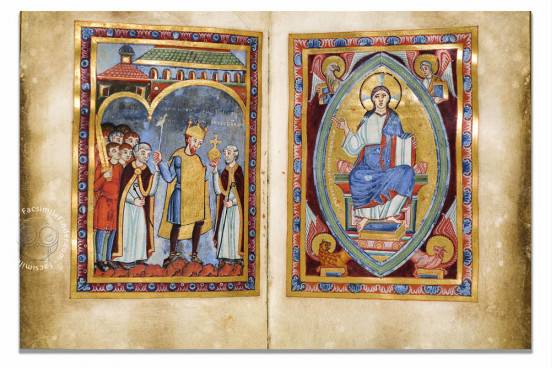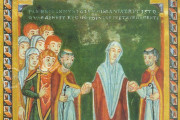The manuscripts produced in Echternach Abbey on behalf of the Salian emperors in the eleventh century are among the most precious products of medieval manuscript art, and the Gospel Lectionary of Emperor Henry III is the crown jewel. Commissioned between 1039 and 1043, this codex offers Latin passages from the New Testament that were intended for reading during church celebrations. The text is accompanied by thirty-eight full-page ornate illustrations, thirteen miniatures, five decorated initials, and three decorated borders.
The smallest of the splendid works from Echternach (19.4 x 14.7 cm), the manuscript likely traveled with him throughout the year, making it one of the most intimately used codices from the Ottonian period.
Prized Amongst Prizes
The eleven elaborately decorated Ottonian manuscripts produced in Echternach Abbey for the Imperial house follow Byzantian models of illustration. The Gospel Lectionary of Emperor Henry III opens with a gorgeous image of King Heinrich's mother Gisela being led across the palace by abbots and her entourage (fol. 3r).
The most famous illustration, however, is a two-page spread across fols. 124v-125r: the Echternach scriptorium and scribes and illuminators of the book are depicted on the left, and the dedication image for King Henry III is on the right, wherein Henry receives an inscribed codex from the abbot that reads: Salus nostra in manu tua est | respiceat super nos misericordia tua ("Our salvation is in your hands | let your mercy breath upon us").
A Highly Skilled Hand
The text is written by a single scribe in a well-executed Caroline minuscule script; the headers for each pericope, important names, and the beginnings of several sentences are written in Uncil.
A Well-documented Provenance
From the death of Henry III (d. 1056) until the sixteenth century, the provenance of the manuscript remains a mystery. However, fol. 1r tells us that "Rabordus Meghes" owned the manuscript in the late sixteenth century before the codex fell into the hands of the Swiss collector Melchio Goldast von Haiminsfeld (b. 1578), who brought the book to Bremen during the 30 Years' War.
In 1646 the Bremen council acquired Goldast's library, but the codex fell into private hands in the second half of the seventeenth century. By the beginning of the eighteenth century, however, the Bibliotheca Bremensis officially acquired the manuscript.
Binding description
The Pericope Book of Henry III has a layered history of restoration and repair. While the original binding is long lost, Goldast rebound the manuscript in a white parchment binding with a white gold edge in 1602 while in Geneva. This Renaissance cover was then removed and replaced with a modern parchment binding complete with diamond-shaped floral stamps in 1939.
The 1939 binding was then removed in 1980 when the manuscript underwent extensive repairs and, after conservators prepared a facsimile in 1981, the original manuscript was stored as individual sheets. Based on the most recent available information, the Pericope was rebound in a green suede cover in 1987.
We have 1 facsimile edition of the manuscript "Gospel Lectionary of Emperor Henry III": Das Evangelistar Kaiser Heinrichs III. facsimile edition, published by Reichert Verlag, 1981
Request Info / Price

